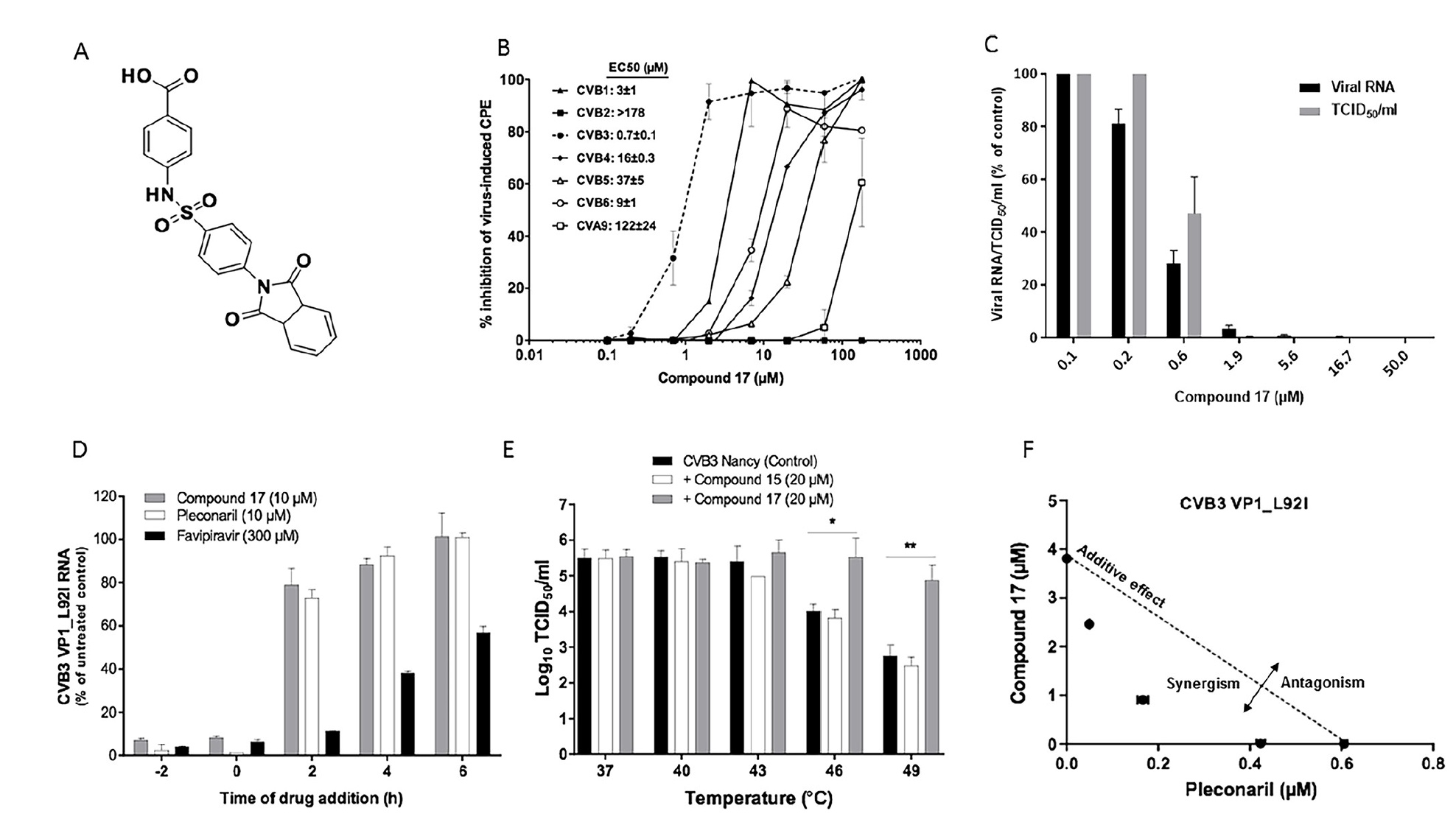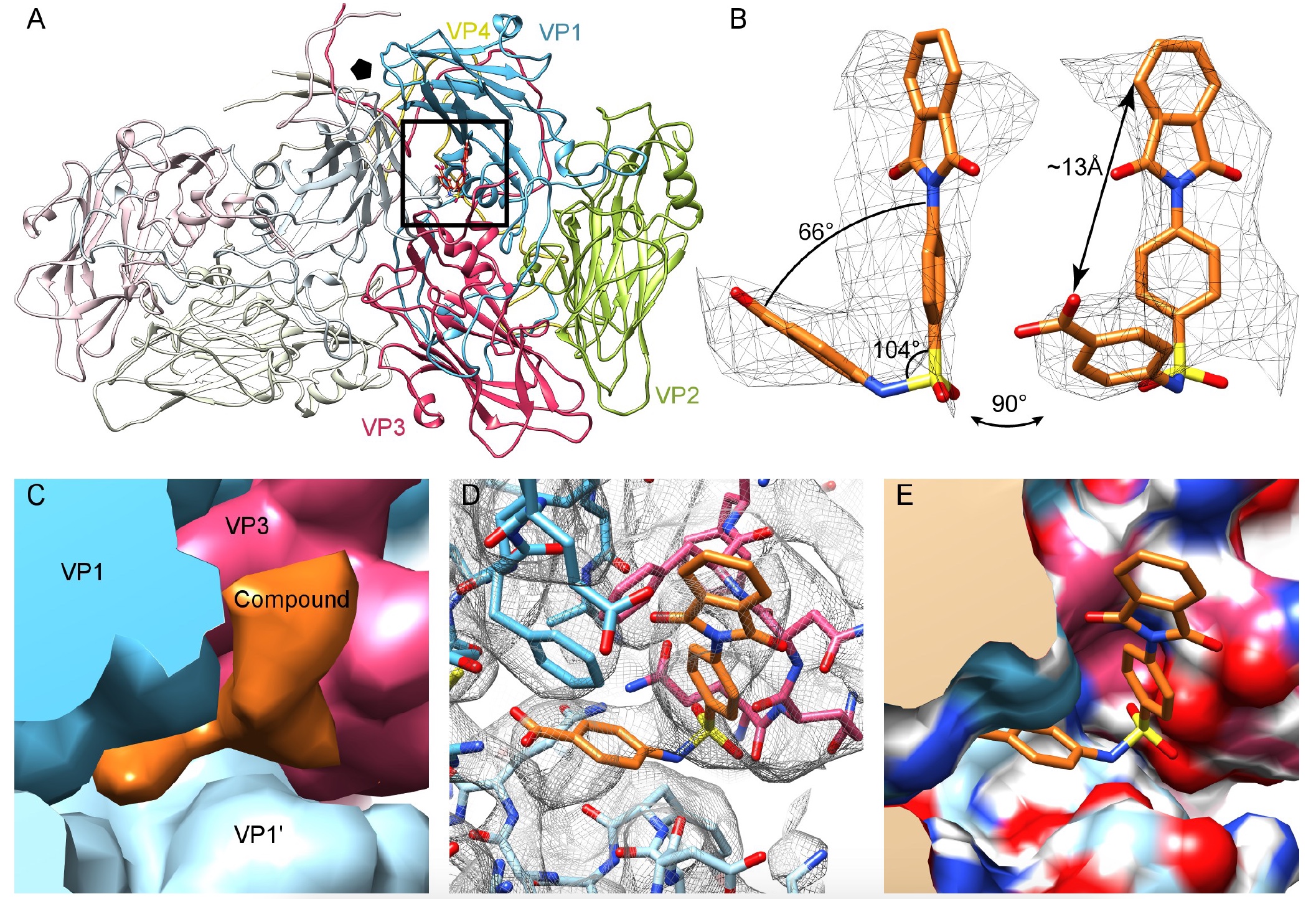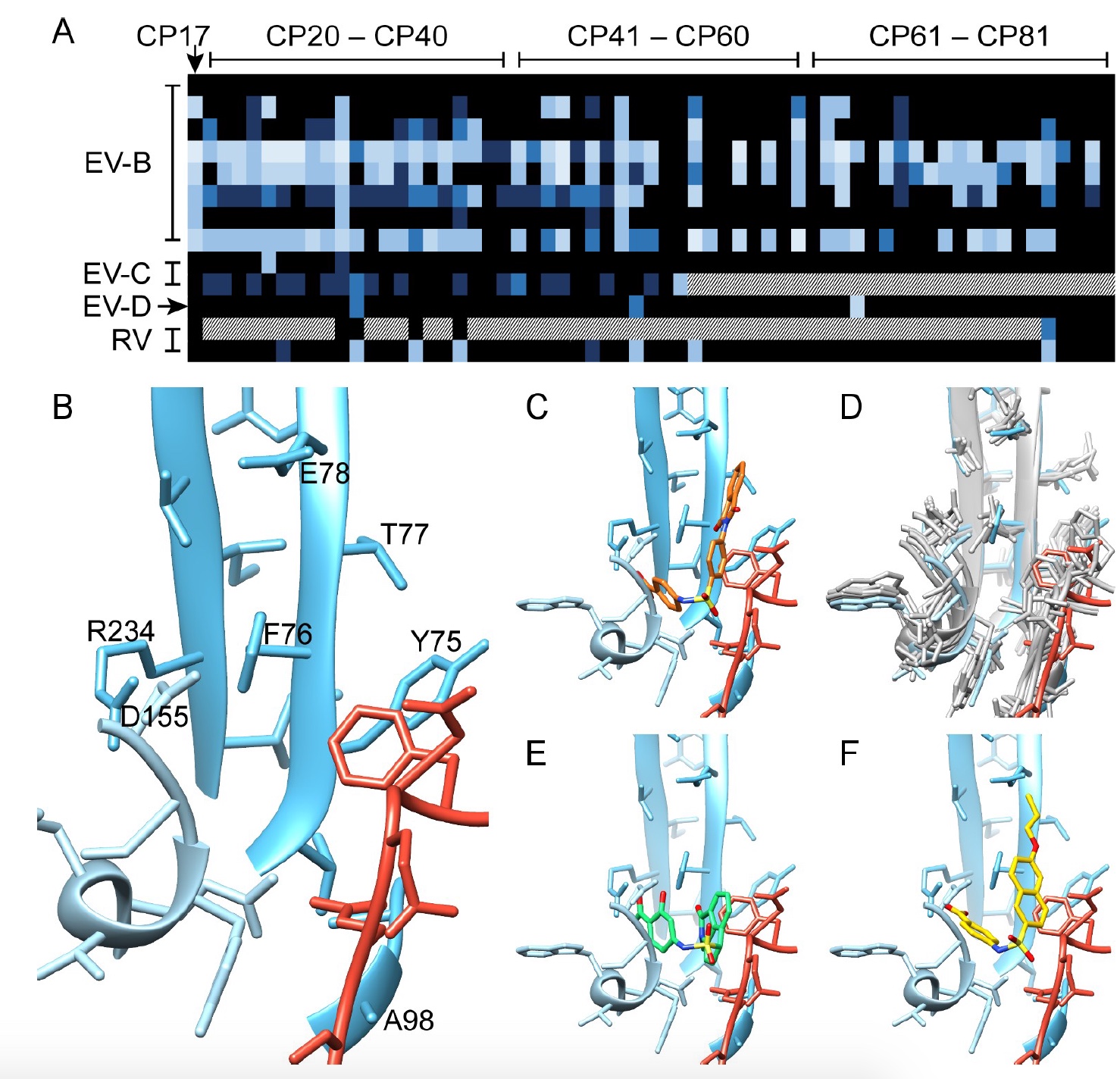Farewell to the common cold: the introduction of drugs in the "pockets" of viruses

Outside the window shines a bright sun, the air is filled with warm moisture, and the saving cool breeze decided to take a vacation, leaving us to be torn apart by the heat. I want to change my jeans to shorts, a laptop to a volleyball, and an office to the beach. Summer is associated with holidays and vacations, but sometimes a guest is squeezed into this idle list, which we usually wait for during the winter months, namely the cold. There is nothing worse to temperature when the air temperature is around 30. SARS in the summer turn a person into a snail, slowly trailing along hot asphalt, leaving behind a slimy trail.
Can saving science help us in the fight against rhinoviruses, you ask? Of course, the scientists who have discovered a new way to fight rhino / enterovirus hidden in a previously unexplored pocket of the virus will answer you. What is this pocket, what do scientists want to shove in it and how will it help to defeat the rhinoviruses? We will find the answers in the report of the research group.
')
The basis of the study
To begin with, we quickly recall what causes ARVI and what it generally is.

Visualization of rhinovirus.
SARS, that is, an acute respiratory viral infection, is the result of the active activity of the virus in the human body, namely in its respiratory system. Such viruses include rhinoviruses from the genus of enteroviruses. One of the main structural features of the rhinovirus is an open virion, that is, a virus particle without a shell.
In humans, rhinoviruses cause inflammation of the upper respiratory tract, because they prefer to multiply in the mucous membrane that covers the nasopharynx. Symptoms in case of infection are fairly standard and familiar to everyone - fever, runny nose, pain in the larynx area. In the absence of treatment and reduced immune response of the body, ARVI can develop into bronchitis, sinusitis or otitis.
Can rhinoviruses be treated and / or vaccinated against them? It is theoretically possible, but almost impossible, since the number of serological variants of the pathogen is very large. Treatment of rhinovirus infections is done by alleviating the symptoms, and the virus itself defeats the immune system.
If we talk about the treatment of viral infection as such, then it is worthwhile to understand the process of the destruction of the virus. As a rule, this is accomplished through the introduction of the drug into it, roughly speaking. At the moment, the most studied inhibitors are capsid binders, which are placed in the hydrophobic pocket of the viral capsid.
In the study we are considering today, scientists have identified a previously unknown pocket that is formed by the VP1 and VP3 viral proteins and is a common feature for different types of entero / rhinoviruses. The introduction of the drug in this pocket will stabilize the key region of the virion, which will prevent the conformational expansion necessary for the release of viral RNA. Consequently, no snot, cough and temperature. Agree, it sounds very inspiring.
Research results

Image number 1
Scientists have found that Compound 17 ( 1a ), which is a derivative of benzenesulfonamide, is a potent inhibitor for the B3 strain of Coxsackie virus. The half-maximal effective concentration (EC50) is 0.7 ± 0.1 μM ( 1b ).
Compound 17 also inhibits the replication of CVB1 and CVB6, shows moderate activity against CVB4, CVB5 and Coxsackie A9 virus (CVA9), but does not react against CVB2 even at the highest tested concentration ( 1b ). Also, this compound is not inhibited in CVA16 and EVA71 (EV-A group), CVA21 and PV1 (EV-C group), EVD68 (EV-D group) and B14 rhinovirus (RVB14, RV-B).
Antiviral activity of compound 17 was further confirmed in a viral load analysis, in which it reduced in a dose-dependent manner the formation of CVB3 and CVB3 RNA with EC50 values of 0.4 ± 0.01 μM and 1.1 ± 0.3 μM, respectively ( 1s ).
Compound 17, like pleconaril (antiviral drug), targets CVB3 replication at an early stage of the viral cycle. In the case of the introduction of compound 17, 2 hours after infection, the antiviral activity is greatly reduced ( 1d ).
Scientists remind us that early-stage inhibitors of enteroviruses (for example, pleconaril) interact with viral capsids and increase their resistance to thermal inactivation. Compound 17 increased the thermal stability of CVB3 by 1.5 at 46 ° C and by 2.1 at 49 ° C ( 1e ).
If we combine compound 17 and pleconaril, then synergistic antiviral activity will be observed. That is, these two substances have different antiviral mechanisms of action ( 1f ).
These observations suggest that compound 17 is well suited for conducting tests related to the detected pocket in the viral capsid.
In order to better consider the process of interaction between compound 17 and the CVB3 viral capsid, scientists performed cryoelectron microscopy.

Image number 2
The capsid protein side chains were easily identified, and the CVB3 Nancy homology model could easily fit into the seal map. In addition, the Nancy cryo-EM strain showed no lipid factor consolidation in the VP1 hydrophobic pocket. However, an analysis of the differences revealed an additional compaction that can be associated with the atomic model of compound 17 ( 2a , 2c ).
As can be seen in image 2b, the compound is L-shaped with a long and short shoulder, which allows for “docking” with connection 17. The simulation showed that connection 17 is connected in your pocket by means of two VP1 blocks and one VP3 block on the interprotomeric interface. In view of the icosahedral type of symmetry of the virus, there can be 60 such regions in one cusp ( 2c ).
The region under consideration is located at a distance of 16 Å from the hydrophobic pocket, which pleconaril is aimed at. Thus, compound 17 does not work in the same place as pleconaril, that is, without interfering with its antiviral activity, but complementing it.
Scientists simulated interactions within proteins, interfaces, structures, and compounds, which showed VP1 (73, 75–78, 155–157.159–160, 219 and 234) and VP3 (233–236) residues that form the pocket ( 2d and 2e ) .
An analysis of the preservation of these pocket residues in the 56 amino acid sequences of CVB3 showed that 7 of the 16 were fully preserved (i.e., inside there is compound 17), and about 14 residues showed a result of 97% preservation. Conservation of the pocket also occurs in all enteroviruses of group B.
However, not all viruses are so easily amenable to inhibition by compound 17. Therefore, it was necessary to understand what makes them so resistant. To do this, scientists conducted a clone selection, highlighting 4 resistance mutations. Three of the four amino acid mutations were located in the immediate vicinity of the pocket (F76C, E78G and A98V), and another one (D133G) was fairly distant.

The degree of influence of compound 17, rupintrivir (inhibitor of 3C protease) and TP0219 (glutathione-depleting compound) on the replication of CVB3 WT and modified CVB3 variants.
Scientists have prepared 12 CVB3 mutants in the CVB3 clone by reverse engineering. A glutathione-independent variant of VPB1_T77M CVB3, resistant to glutathione-depleting compound TP0219, was also created.
Only eight of the 12 mutants proved to be viable ( 2d ), 7 of them were resistant to compound 17 and react equally to rupintrivir.
The study of the only distant mutation distant from the pocket showed that VP1_D133G is more resistant to heat than CVB3 Nancy, and compound 17 can still stabilize it. That is, VP1_D133G is a compensatory mutation, and not a mutation, which prevents binding of compound 17.
But VP1_T77 was involved in the binding of glutathione. The analysis showed that glutathione-independent variant VP1_T77M CVB3 has a reduced sensitivity to compound 17. It was also established that ethyl glutathione ester did not affect the antiviral activity of compound 17 even at the highest concentration tested.
Next, scientists tested the degree of potential effect of compound 17 on viral receptor binding. For this, the human coxsackie virus protein and the adenovirus receptor (hCAR), linked in a chain, were used. The binding affinity of CVB3 did not decrease in the presence of compound 17 even at the highest concentration tested. In addition, compound 17 was active against CD55-dependent * enterovirus B (E-11 virus).
CD55 (acceleration factor of complement disintegration) * - membrane protein, inhibitor of the complement system.Experimental data are also confirmed by the fact that the Coxsaki receptor binding sites + adenovirus virus and CD55 + CVB3 do not intersect with the pocket.
Thus, scientists have found that compound 17 is perfectly embedded in the capsid pocket of various viruses. The next stage of the study is to test the effectiveness of the drug being introduced into this pocket.

Image number 3
During this test, both commercially available substances (compounds 20-50) and modifications made in the laboratory - compounds 51-81 were used.
Knowledge of the activity of compound 17 allowed to isolate specific characteristics necessary for the future drug. Scientists analyzed information from antiviral assays and used it in the synthesis of more active analogs of compound 17.
The synthesis resulted in analogues that showed activity against a number of enteroviruses: EV-B (CVB), EV-C (PV1 and CVA21), EV-D (EVD68), RV-A (RVA09, RVA59 and RVA63) and RV-B ( RVB14) ( 3a ). Unfortunately, none of the compounds created were active against EVA viruses (CVA16 and EVA71).

Compounds with maximum potential activity against certain viruses.
Among all the analogues, compounds 29 and 48 were active against all 6 tested CVBs (Koskasi group B viruses). Compound 48 completely inhibited the replication of PV1 at a concentration of 144 μM. Compound 77 showed antiviral activity against RV-A and RV-B.
As seen in image number 3, the shape of the new molecules complements the shape of the pocket. Scientists were able to establish a clear structure-property relationship (chemical structure of the molecule to its biological activity) from the carboxyl group at position R3, where the hydrogen atom is necessary for antiviral activity, and at position R2, where the hydroxyl group demonstrates its usefulness for a broad antiviral effect. Cryo-EM structuring has shown that there is a charge complementarity between R3 and the inhibited VP1_R234 residue.
The totality of the results of the tests performed indicates a fairly high degree of introduction of the tested compounds into the pockets of the capsid viruses from various groups.
For a more detailed acquaintance with the nuances of the study I recommend to look into the report of scientists ( here or here )
Epilogue
Summing up, scientists have found pockets in the structure of enteroviruses that can be filled with drugs that prevent the spread of the virus or completely destroy it.
The main hero was compound 17 and its modified counterparts, which showed a high degree of activity against CVB3. The revealed pockets are quite similar to each other in different groups of viruses, which allows for the further development of broad-spectrum drugs.
In other words, viruses that nobody has previously cured can now be easily overcome. Of course, relying solely on the human immune system is not the most sensible idea, given the number of diseases and abnormalities that can disrupt its work, opening the doors to the human body to a variety of viruses. Such research and development is extremely important in our time, given the growth of the planet’s population and the speed of urbanization. And these figures greatly affect the rate of spread of viral infections. Moreover, having a drug that can overcome the virus at the root, a person will not need to deal with each symptom separately, that is, to buy a bunch of other drugs (drops, sprays, tablets, suspensions, etc., etc.).
Scientists will continue their work, focusing on finding compounds that will be as effective as possible against the maximum possible number of viruses. We can only wish them good luck and, until they bring the matter to the end, to deal with a cold by their own strength.
Friday off-top:
Not only people suffer from viruses, but also computers, and sometimes animated characters. ( The second series here.)
Thank you for your attention, remain curious, take care of your health and have a great weekend. :)
Not only people suffer from viruses, but also computers, and sometimes animated characters. ( The second series here.)
Thank you for your attention, remain curious, take care of your health and have a great weekend. :)
Thank you for staying with us. Do you like our articles? Want to see more interesting materials? Support us by placing an order or recommending to friends, 30% discount for Habr's users on a unique analogue of the entry-level servers that we invented for you: The Truth About VPS (KVM) E5-2650 v4 (6 Cores) 10GB DDR4 240GB SSD 1Gbps $ 20 or how to share the server? (Options are available with RAID1 and RAID10, up to 24 cores and up to 40GB DDR4).
Dell R730xd 2 times cheaper? Only we have 2 x Intel TetraDeca-Core Xeon 2x E5-2697v3 2.6GHz 14C 64GB DDR4 4x960GB SSD 1Gbps 100 TV from $ 199 in the Netherlands! Dell R420 - 2x E5-2430 2.2Ghz 6C 128GB DDR3 2x960GB SSD 1Gbps 100TB - from $ 99! Read about How to build an infrastructure building. class c using servers Dell R730xd E5-2650 v4 worth 9000 euros for a penny?
Source: https://habr.com/ru/post/456038/
All Articles